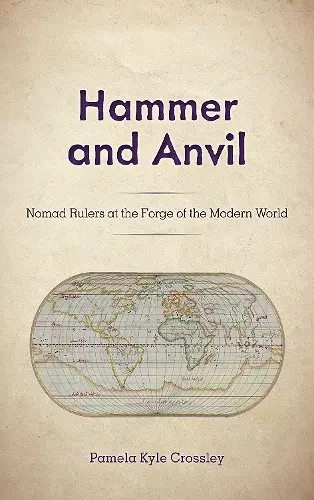Hammer and Anvil
Nomad Rulers at the Forge of the Modern World
Format:Hardback
Publisher:Rowman & Littlefield
Published:28th Feb '19
Currently unavailable, and unfortunately no date known when it will be back

This groundbreaking book examines the role of rulers with nomadic roots in transforming the great societies of Eurasia, especially from the thirteenth to sixteenth centuries. Distinguished historian Pamela Kyle Crossley, drawing on the long history of nomadic confrontation with Eurasia’s densely populated civilizations, argues that the distinctive changes we associate with modernity were founded on vernacular literature and arts, rising literacy, mercantile and financial economies, religious dissidence, independent learning, and self-legitimating rulership. Crossley finds that political traditions of Central Asia insulated rulers from established religious authority and promoted the objectification of cultural identities marked by language and faith, which created a mutual encouragement of cultural and political change. As religious and social hierarchies weakened, political centralization and militarization advanced. But in the spheres of religion and philosophy, iconoclasm enjoyed a new life. The changes cumulatively defined a threshold of the modern world, beyond which lay early nationalism, imperialism, and the novel divisions of Eurasia into “East” and “West.” Synthesizing new interpretive approaches and grand themes of world history from 1000 to 1500, Crossley reveals the unique importance of Turkic and Mongol regimes in shaping Eurasia’s economic, technological, and political evolution toward our modern world.
Pamela Crossley’s magnificent book is a deeply historical study that seeks to compel a profound reassessment of the place of Eurasian thought in the genealogy of modernity. It contends—on the basis of massive evidence quarried from a stunningly capacious and deftly argued reading of the connected histories of Inner Eurasia from the East Asian Steppe to eastern Europe—that we really need to rethink the role of nomads in world history. Is the modern world European? Or is its genealogy more complex and far-reaching? Crossley argues that before it was declared by Renaissance thinkers to be the special heritage of the West, Greek thought was deeply imbricated in the world-bestriding, multiconfessional civilization of Eurasia. And therein hangs a tale. In so doing she provokes a much overdue and critically important historical argument. -- Edmund Burke III, University of California at Santa Cruz
Pamela Crossley takes the reader beyond the comfort zone of civilizations and into a realm of uncommon knowledge, which illuminates the key role played by the nomads of Eurasia in shaping the late medieval and modern world. Premodern and early modern global history cannot be understood without such knowledge, and Crossley’s expert weaving of traditions and transformations, religions and beliefs, events, and debates brings the question of nomadic heritage in an engaging dialogue with modernity and to the forefront of a global historical consciousness. -- Nicola Di Cosmo, Institute for Advanced Study
Pamela Crossley demonstrates the vital role of Turkic and Mongolian nomads in shaping the modern world. They constructed a common Eurasian cultural matrix, which connected religious beliefs, technologies, and techniques of political legitimation that crossed civilizational divides. Sweeping over centuries and covering vast spaces, this book is filled with provocative assertions and penetrating insights. It uncovers the large-scale trends that unified states and societies across Eurasia, giving us a remarkably refreshing perspective on our own times. -- Peter C. Perdue, Yale University
Pamela Crossley’s remarkable book is an ambitious and original treatment of several centuries of Eurasian history, arguing that nomadic empires and their rulers contributed in important ways to changes which led to ‘modernity.’ Only a historian of her breadth of knowledge and imagination could write such a book. It is both thought-provoking and persuasive. -- David Morgan, University of Wisconsin–Madison
ISBN: 9781442214439
Dimensions: 237mm x 157mm x 25mm
Weight: 617g
360 pages